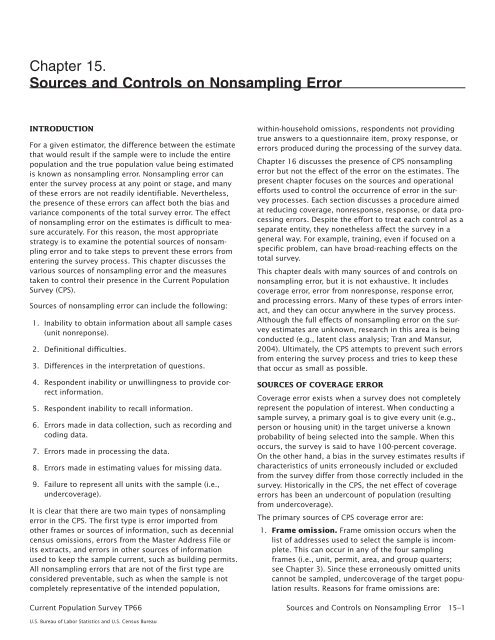Current Population Survey Design and Methodology - Census Bureau
Current Population Survey Design and Methodology - Census Bureau
Current Population Survey Design and Methodology - Census Bureau
You also want an ePaper? Increase the reach of your titles
YUMPU automatically turns print PDFs into web optimized ePapers that Google loves.
Chapter 15.<br />
Sources <strong>and</strong> Controls on Nonsampling Error<br />
INTRODUCTION<br />
For a given estimator, the difference between the estimate<br />
that would result if the sample were to include the entire<br />
population <strong>and</strong> the true population value being estimated<br />
is known as nonsampling error. Nonsampling error can<br />
enter the survey process at any point or stage, <strong>and</strong> many<br />
of these errors are not readily identifiable. Nevertheless,<br />
the presence of these errors can affect both the bias <strong>and</strong><br />
variance components of the total survey error. The effect<br />
of nonsampling error on the estimates is difficult to measure<br />
accurately. For this reason, the most appropriate<br />
strategy is to examine the potential sources of nonsampling<br />
error <strong>and</strong> to take steps to prevent these errors from<br />
entering the survey process. This chapter discusses the<br />
various sources of nonsampling error <strong>and</strong> the measures<br />
taken to control their presence in the <strong>Current</strong> <strong>Population</strong><br />
<strong>Survey</strong> (CPS).<br />
Sources of nonsampling error can include the following:<br />
1. Inability to obtain information about all sample cases<br />
(unit nonreponse).<br />
2. Definitional difficulties.<br />
3. Differences in the interpretation of questions.<br />
4. Respondent inability or unwillingness to provide correct<br />
information.<br />
5. Respondent inability to recall information.<br />
6. Errors made in data collection, such as recording <strong>and</strong><br />
coding data.<br />
7. Errors made in processing the data.<br />
8. Errors made in estimating values for missing data.<br />
9. Failure to represent all units with the sample (i.e.,<br />
undercoverage).<br />
It is clear that there are two main types of nonsampling<br />
error in the CPS. The first type is error imported from<br />
other frames or sources of information, such as decennial<br />
census omissions, errors from the Master Address File or<br />
its extracts, <strong>and</strong> errors in other sources of information<br />
used to keep the sample current, such as building permits.<br />
All nonsampling errors that are not of the first type are<br />
considered preventable, such as when the sample is not<br />
completely representative of the intended population,<br />
<strong>Current</strong> <strong>Population</strong> <strong>Survey</strong> TP66<br />
U.S. <strong>Bureau</strong> of Labor Statistics <strong>and</strong> U.S. <strong>Census</strong> <strong>Bureau</strong><br />
within-household omissions, respondents not providing<br />
true answers to a questionnaire item, proxy response, or<br />
errors produced during the processing of the survey data.<br />
Chapter 16 discusses the presence of CPS nonsampling<br />
error but not the effect of the error on the estimates. The<br />
present chapter focuses on the sources <strong>and</strong> operational<br />
efforts used to control the occurrence of error in the survey<br />
processes. Each section discusses a procedure aimed<br />
at reducing coverage, nonresponse, response, or data processing<br />
errors. Despite the effort to treat each control as a<br />
separate entity, they nonetheless affect the survey in a<br />
general way. For example, training, even if focused on a<br />
specific problem, can have broad-reaching effects on the<br />
total survey.<br />
This chapter deals with many sources of <strong>and</strong> controls on<br />
nonsampling error, but it is not exhaustive. It includes<br />
coverage error, error from nonresponse, response error,<br />
<strong>and</strong> processing errors. Many of these types of errors interact,<br />
<strong>and</strong> they can occur anywhere in the survey process.<br />
Although the full effects of nonsampling error on the survey<br />
estimates are unknown, research in this area is being<br />
conducted (e.g., latent class analysis; Tran <strong>and</strong> Mansur,<br />
2004). Ultimately, the CPS attempts to prevent such errors<br />
from entering the survey process <strong>and</strong> tries to keep these<br />
that occur as small as possible.<br />
SOURCES OF COVERAGE ERROR<br />
Coverage error exists when a survey does not completely<br />
represent the population of interest. When conducting a<br />
sample survey, a primary goal is to give every unit (e.g.,<br />
person or housing unit) in the target universe a known<br />
probability of being selected into the sample. When this<br />
occurs, the survey is said to have 100-percent coverage.<br />
On the other h<strong>and</strong>, a bias in the survey estimates results if<br />
characteristics of units erroneously included or excluded<br />
from the survey differ from those correctly included in the<br />
survey. Historically in the CPS, the net effect of coverage<br />
errors has been an undercount of population (resulting<br />
from undercoverage).<br />
The primary sources of CPS coverage error are:<br />
1. Frame omission. Frame omission occurs when the<br />
list of addresses used to select the sample is incomplete.<br />
This can occur in any of the four sampling<br />
frames (i.e., unit, permit, area, <strong>and</strong> group quarters;<br />
see Chapter 3). Since these erroneously omitted units<br />
cannot be sampled, undercoverage of the target population<br />
results. Reasons for frame omissions are:<br />
Sources <strong>and</strong> Controls on Nonsampling Error 15–1

















